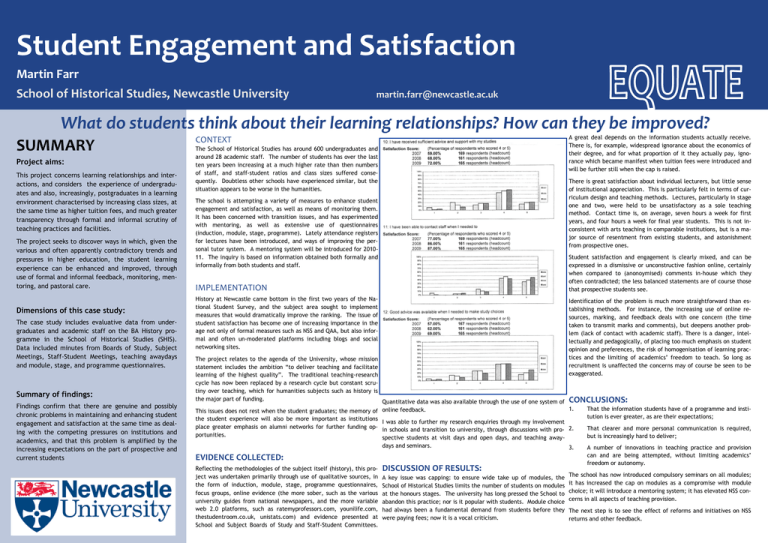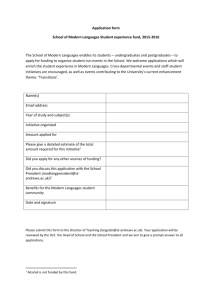Student Engagement and Satisfaction SUMMARY Martin Farr
advertisement

Student Engagement and Satisfaction Martin Farr School of Historical Studies, Newcastle University martin.farr@newcastle.ac.uk What do students think about their learning relationships? How can they be improved? SUMMARY Project aims: This project concerns learning relationships and interactions, and considers the experience of undergraduates and also, increasingly, postgraduates in a learning environment characterised by increasing class sizes, at the same time as higher tuition fees, and much greater transparency through formal and informal scrutiny of teaching practices and facilities. The project seeks to discover ways in which, given the various and often apparently contradictory trends and pressures in higher education, the student learning experience can be enhanced and improved, through use of formal and informal feedback, monitoring, mentoring, and pastoral care. Dimensions of this case study: The case study includes evaluative data from undergraduates and academic staff on the BA History programme in the School of Historical Studies (SHIS). Data included minutes from Boards of Study, Subject Meetings, Staff-Student Meetings, teaching awaydays and module, stage, and programme questionnaires. Summary of findings: Findings confirm that there are genuine and possibly chronic problems in maintaining and enhancing student engagement and satisfaction at the same time as dealing with the competing pressures on institutions and academics, and that this problem is amplified by the increasing expectations on the part of prospective and current students A great deal depends on the information students actually receive. There is, for example, widespread ignorance about the economics of their degree, and for what proportion of it they actually pay, ignorance which became manifest when tuition fees were introduced and will be further still when the cap is raised. CONTEXT The School of Historical Studies has around 600 undergraduates and around 28 academic staff. The number of students has over the last ten years been increasing at a much higher rate than then numbers of staff, and staff-student ratios and class sizes suffered consequently. Doubtless other schools have experienced similar, but the situation appears to be worse in the humanities. There is great satisfaction about individual lecturers, but little sense of institutional appreciation. This is particularly felt in terms of curriculum design and teaching methods. Lectures, particularly in stage one and two, were held to be unsatisfactory as a sole teaching method. Contact time is, on average, seven hours a week for first years, and four hours a week for final year students. This is not inconsistent with arts teaching in comparable institutions, but is a major source of resentment from existing students, and astonishment from prospective ones. The school is attempting a variety of measures to enhance student engagement and satisfaction, as well as means of monitoring them. It has been concerned with transition issues, and has experimented with mentoring, as well as extensive use of questionnaires (induction, module, stage, programme). Lately attendance registers for lectures have been introduced, and ways of improving the personal tutor system. A mentoring system will be introduced for 201011. The inquiry is based on information obtained both formally and informally from both students and staff. Student satisfaction and engagement is clearly mixed, and can be expressed in a dismissive or unconstructive fashion online, certainly when compared to (anonoymised) comments in-house which they often contradicted; the less balanced statements are of course those that prospective students see. IMPLEMENTATION History at Newcastle came bottom in the first two years of the National Student Survey, and the subject area sought to implement measures that would dramatically improve the ranking. The issue of student satisfaction has become one of increasing importance in the age not only of formal measures such as NSS and QAA, but also informal and often un-moderated platforms including blogs and social networking sites. Identification of the problem is much more straightforward than establishing methods. For instance, the increasing use of online resources, marking, and feedback deals with one concern (the time taken to transmit marks and comments), but deepens another problem (lack of contact with academic staff). There is a danger, intellectually and pedagogically, of placing too much emphasis on student opinion and preferences, the risk of homogenisation of learning practices and the limiting of academics’ freedom to teach. So long as recruitment is unaffected the concerns may of course be seen to be exaggerated. The project relates to the agenda of the University, whose mission statement includes the ambition “to deliver teaching and facilitate learning of the highest quality”. The traditional teaching-research cycle has now been replaced by a research cycle but constant scrutiny over teaching, which for humanities subjects such as history is the major part of funding. Quantitative data was also available through the use of one system of CONCLUSIONS: 1. That the information students have of a programme and instiThis issues does not rest when the student graduates; the memory of online feedback. tution is ever greater, as are their expectations; the student experience will also be more important as institutions I was able to further my research enquiries through my involvement place greater emphasis on alumni networks for further funding op- in schools and transition to university, through discussions with pro- 2. That clearer and more personal communication is required, portunities. but is increasingly hard to deliver; spective students at visit days and open days, and teaching awaydays and seminars. 3. A number of innovations in teaching practice and provision EVIDENCE COLLECTED: Reflecting the methodologies of the subject itself (history), this project was undertaken primarily through use of qualitative sources, in the form of induction, module, stage, programme questionnaires, focus groups, online evidence (the more sober, such as the various university guides from national newspapers, and the more variable web 2.0 platforms, such as ratemyprofessors.com, younilife.com, thestudentroom.co.uk, unistats.com) and evidence presented at School and Subject Boards of Study and Staff-Student Committees. DISCUSSION OF RESULTS: A key issue was capping: to ensure wide take up of modules, the School of Historical Studies limits the number of students on modules at the honours stages. The university has long pressed the School to abandon this practice; nor is it popular with students. Module choice had always been a fundamental demand from students before they were paying fees; now it is a vocal criticism. can and are being attempted, without limiting academics’ freedom or autonomy. The school has now introduced compulsory seminars on all modules; it has increased the cap on modules as a compromise with module choice; it will introduce a mentoring system; it has elevated NSS concerns in all aspects of teaching provision. The next step is to see the effect of reforms and initiatives on NSS returns and other feedback.


